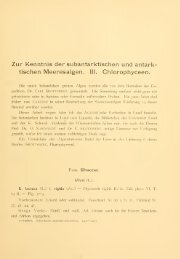Download PDF
Download PDF
Download PDF
Create successful ePaper yourself
Turn your PDF publications into a flip-book with our unique Google optimized e-Paper software.
MOUGEOTIA 8i<br />
not be cited as proof that the aplanospores so commonly found<br />
among the Mougeotias are the result of lateral conjugation.<br />
Two unusual growth processes occur among several species of<br />
Mougeotia, of which M. genuflexa and M. reinschii are the commonest<br />
examples; these are adhesion and genuflexion. It is true<br />
that as new filaments appear in some permanent ponds, new<br />
adhesions and genuflexions may continue to develop for several<br />
successive months. Apparently cells coming in contact produce<br />
growth substances which cause pectinization of the walls in contact<br />
and increased growth of the wall at the point of contact. The<br />
first results in adhesion; the second in genuflexion.<br />
Genuflexion is not an early stage in conjugation that has been<br />
terminated before the development of tubes. There is no evidence<br />
that it has either an advantage or a purpose, although various<br />
authors have sought to find one. In one pond in which the process<br />
occurred throughout the growing season during several successive<br />
years, the interlocked filaments survived for a short time and then<br />
fragmented and went to the bottom. No zygospores were ever<br />
collected from this pond during the six years of observation.<br />
The steps in conjugation in the Mougeotias as in the other<br />
genera in this family are probably activated in the same manner<br />
as those observed by J. R. Raper in Achlya {Amer. Jour. Bot.<br />
[1939-40]), a fungus in which the succession of hormones seems<br />
to have been established clearly.<br />
Analogous changes occur in sexual reproduction though the<br />
cells are not necessarily in contact. The first visible changes are<br />
the growth of two papillae from nearby cells, until they meet,<br />
adhere, and the walls in contact are dissolved. Possibly other<br />
hormones lead to the movement of the protoplasts of both gam-<br />
etangia into the conjugating tube, which meanwhile has greatly<br />
enlarged, and growth has resulted in a form characteristic of the<br />
species. Then follows the union of gametes and the deposition<br />
of successive layers of the spore wall.<br />
With a few exceptions zygospores and aplanospores of Mou-<br />
geotia have only two walls—an outer chitinous wall variously<br />
colored and ornamented, and an inner transparent wall. In many<br />
species the spores are enclosed by a sporangium wall, in others<br />
the sporangium is merely a combination of gametangial and tube<br />
walls. In some species the outer layer of the sporangium wall<br />
changes to pectic compounds and forms a transparent layer 2 to




